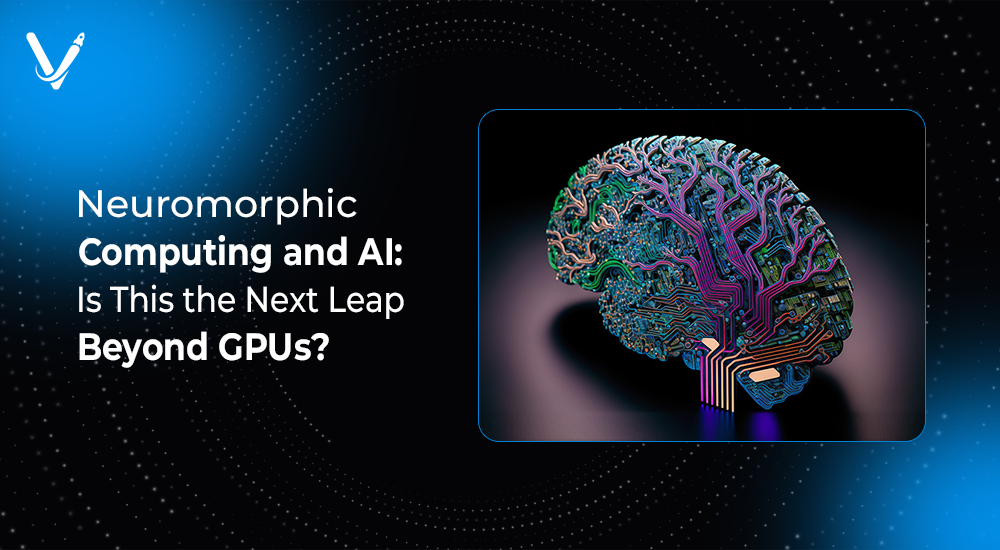Neuromorphic Computing and AI: Is This the Next Leap Beyond GPUs?


- Aug 17, 2025



For years, the graphics processing unit (GPU) has been the powerhouse behind artificial intelligence (AI). GPUs transformed deep learning by crunching massive datasets at record speed, making computer vision, natural language processing, and autonomous driving possible at scale. But as AI applications grow more complex, traditional GPU architectures are hitting limits in efficiency, scalability, and power consumption.
Neuromorphic computing—a brain-inspired approach that aims to replicate how neurons and synapses process information. Instead of brute-force parallelism, neuromorphic chips mimic biological intelligence, promising energy efficiency, adaptability, and real-time learning. This article explores what neuromorphic computing is, why it matters, how it compares to GPUs, and whether it represents the next paradigm shift in AI.
Neuromorphic computing is a paradigm of hardware design inspired by the structure and function of the human brain. Unlike traditional von Neumann architectures that separate memory and computation, neuromorphic systems integrate them—mirroring how neurons store and process information simultaneously.
This architecture is not just a new way to build chips—it’s an attempt to merge computational science with neuroscience.
GPUs revolutionized AI, but they are not designed for brain-like intelligence. Their strengths lie in high-throughput matrix multiplications, not adaptive learning or sparse, event-driven activity.
This bottleneck fuels the search for alternative architectures—hence the interest in neuromorphic chips.
Neuromorphic hardware aims to go beyond brute force, emulating the efficiency of the human brain.
Traditional artificial neural networks (ANNs) use continuous values to represent activations. Neuromorphic models, however, rely on spikes—short bursts of activity—making computations sparse and efficient. This mimics how real neurons communicate through action potentials.
Instead of constantly computing, neuromorphic chips process only when events occur, just like the brain. This drastically reduces energy usage.
Several organizations are driving neuromorphic innovation, each with different architectures and goals.
Companies like BrainChip, SynSense, and Innatera are commercializing neuromorphic chips for edge AI applications like drones, wearables, and smart sensors.
The critical question is: can neuromorphic computing truly replace GPUs, or will they coexist?
| Feature | GPUs | Neuromorphic Chips |
| Architecture | Matrix-based | Brain-inspired |
| Efficiency | High power usage | Ultra-low power |
| Scalability | Limited by Moore’s law | Biologically scalable |
| Adaptability | Fixed weights, retraining needed | Real-time adaptation |
| Use Cases | Large-scale training | Edge AI, adaptive tasks |
The answer may not be one over the other but rather a hybrid ecosystem, where GPUs train large models while neuromorphic chips run adaptive inference on devices.
Neuromorphic computing isn’t just theoretical—it’s already proving valuable in certain domains.
Robots need low-latency decision-making. Neuromorphic chips allow real-time adjustments to changing environments without offloading to cloud GPUs.
Smartphones, IoT sensors, and wearables benefit from energy-efficient intelligence. Neuromorphic chips extend battery life while enabling always-on AI.
Real-time perception and decision-making demand brain-like efficiency. Neuromorphic systems could complement GPUs in processing sensor data faster and with less power.
Neuromorphic chips can power brain-machine interfaces, prosthetics, and real-time monitoring devices with efficiency and adaptability.
Despite its promise, neuromorphic technology faces hurdles.
These challenges mean neuromorphic computing may take years to mature into mainstream adoption.
The future likely lies in hybridization. GPUs will remain essential for large-scale training, but neuromorphic chips could dominate in inference and adaptive learning.
AI systems may combine GPU-powered training with neuromorphic-powered inference, balancing brute-force computation with efficient, adaptive intelligence.
Neuromorphic hardware could directly integrate with human neural signals, powering advanced prosthetics and medical devices.
As sustainability becomes a priority, neuromorphic computing offers a path toward green AI, drastically reducing energy costs compared to GPU farms.
Neuromorphic computing is not yet a replacement for GPUs, but it signals where AI hardware is headed. With ongoing breakthroughs in brain-inspired design, adaptive intelligence, and event-driven processing, neuromorphic chips may become the backbone of next-generation AI systems—especially in applications demanding real-time learning and efficiency.
The journey beyond GPUs is about breaking free from traditional architectures. Neuromorphic computing represents a bold attempt to bring AI closer to the way human intelligence functions—efficient, adaptable, and sustainable. While GPUs will continue to drive large-scale model training, neuromorphic systems may power the edge of intelligence, embedded in devices all around us.
At Vasundhara Infotech, we keep a close eye on such technological shifts to deliver cutting-edge solutions in AI, software development, and next-gen computing. If your business wants to explore how emerging technologies like neuromorphic AI can unlock efficiency and innovation, connect with our experts today.
What is neuromorphic computing in simple terms?
It’s a brain-inspired way of designing computer chips that process information like neurons and synapses, enabling efficient AI.
How does neuromorphic computing differ from GPUs?
GPUs rely on high-power parallel matrix calculations, while neuromorphic chips use event-driven spikes, consuming far less energy.
Is neuromorphic computing available today?
Yes, companies like Intel, IBM, and BrainChip have developed prototypes and early-stage commercial chips.
Will neuromorphic chips replace GPUs?
Not entirely. GPUs will dominate training, while neuromorphic chips may excel at real-time inference on edge devices.
Why is neuromorphic computing important for AI?
It promises energy-efficient, adaptive intelligence, enabling AI applications to run on small devices without cloud dependence.
Copyright © 2025 Vasundhara Infotech. All Rights Reserved.